Naming conventions
The manufacturer applied the widely followed German naming conventions of the time. On the Benz 10/30 PS the “10” defined the car's tax horsepower, used by the authorities to determine the level of annual car tax to be imposed on car owners. The “30” defined the manufacturer's claims regarding car's actual power output as defined in metric horsepower. In Germany tax horsepower, which had been defined by statute since 1906, was based on the dimensions of the cylinders in the engine. Unlike the systems used elsewhere in Europe, the German tax horsepower calculation took account both of the cylinder bore and of the cylinder stroke, and there was therefore a direct linear relationship between engine size and tax horsepower.
Although the car would have been promoted in its time as the 10/25 PS, the 10/30 PS or the 10/35 PS according to its actual power output at the time, in retrospect it is often known simply as the Benz 10 PS in order to avoid having to explain name changes during the model's production period.
The car
The car presented in 1912 was powered by a four-cylinder "in-line" engine of 2,610 cc delivering a maximum of 25 PS (18 kW; 25 hp) at 1,600 rpm. Power passed through a leather cone clutch (“Lederkonuskupplung“) via a four-speed transmission and steel propeller shaft to the rear wheels. Top speed was given as approximately 70 km/h (45 mph).
In the same year the manufacturer announced a more powerful engine, unchanged in size, but now providing 30 PS (22 kW; 30 hp) of power at 1,750 rpm. [2] Unusually at this time the four cylinders were in a single block formed from a single casting, rather than being set in a pair of two twin-cylinder blocks. The mechanically controlled brakes operated on the drive shaft until 1925 when the braking system was reconfigured and the brakes operated on all four wheels.
The bodies normally offered were for a Torpedo bodied “Tourenwagen” or a ”Limousine” (sedan/saloon). [3] In parallel with the standard length chassis the manufacturer also offered a “Sport Runabout”, its wheelbase being reduced in length by 100 mm (3.9 in). The wooden-spoked wheels were attached to rigid axles suspended with simple leaf springs. Towards the end, some of the cars were produced with steel-spoked wheels. [4]
1920s upgrades
Benz sales literature from 1921 shows a return of the 10/30 PS with a water-cooled engine the same size as before, but thermosyphon cooling had now replaced the earlier pump based cooling system. Claimed maximum output remained at 30 PS (22 kW; 30 hp) but this was now achieved at the higher engine speed of 2,000 rpm. The position of the gear lever moved in 1923 from the outside of the car on the right side to what would subsequently become a more conventional position in the middle of the floor. [5] (The driver of a Benz 10/30 PS sat on the right side of the car, which at this time was still virtually universal in Europe.)
From 1925 the brakes were rearranged, now operating on all four wheels rather than directly on the drive shaft.
In 1926 claimed maximum power from the 2,610 cc engine was increased to at 35 PS (26 kW; 35 hp) which necessarily triggered a name change, cars from this period being sold as the Benz 10/35 PS. By now a top speed of 80 km/h (50 mph) was being quoted. [6]

The Opel 4 PS, popularly known as the Laubfrosch (treefrog), is a small two-seater car introduced by the auto maker Opel early in 1924. Subsequently, various versions of the little Laubfrosch were produced until it was replaced by the Opel 1.2 litre.

The Adler Diplomat is a substantial six-cylinder “limousine” (saloon) built by the Frankfurt auto-maker, Adler. It was introduced in March 1934 as a direct replacement for the manufacturer's Standard 6. Less directly the six-cylinder Diplomat also replaced the Adler Standard 8 since Adler's large eight-cylinder car was discontinued in 1934 without a direct replacement of its own.

The Mercedes-Benz W10 was a touring car produced by Mercedes-Benz from 1929 to 1934, replacing the W03/Typ 350 models. The structure originated by Ferdinand Porsche was modified by Hans Nibel.

The Mercedes-Benz 380 is an eight-cylinder powered automobile introduced by the German manufacturer Mercedes-Benz at the Berlin Motor Show in February 1933. It was withdrawn from production during 1934. Several models with similar names were produced by Mercedes-Benz during the 1930s, so that in retrospect the car is frequently identified using the manufacturer's Works Number as the W22.
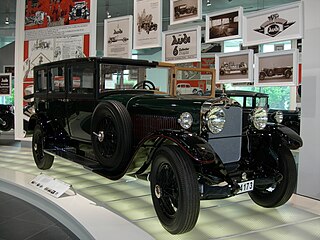
The Audi Type M was a large car first presented at the Berlin Motor Show in 1923 and produced by Audi between 1924 and 1927.

The Audi Type SS was a large, eight-cylinder-powered sedan/saloon car introduced by Audi in 1929 in succession to the Type R "Imperator".

The Adler Favorit is a passenger car introduced early in 1929 by the Frankfurt auto-maker, Adler. It was a substantial six cylinder “limousine” (saloon) closely modelled on the manufacturer’s Standard 6 which had first appeared in public in October 1926. The two models shared the same 2,840 mm (112 in) wheelbase, but the Favorit was powered by a smaller 1,943 cc 4-cylinder engine for which a maximum power output of 35 PS was claimed. For both cars, a range of alternative body styles were available from coach builders.

The Opel 1,2 Liter is a small car manufactured by Opel between 1931 and 1935. The 1,2 Liter was replaced in 1935 by the Opel P4 which was broadly similar but employed a new engine and continued in production until December 1937. For just one year, in 1933, the manufacturer also offered the Opel 1,0 Liter which was a smaller engined version of the 1,2 Liter. The Opel 1,2 Liter replaced the last version of the Opel Laubfrosch and was itself first complemented and then effectively replaced by the more roomy Opel Kadett, which had itself already entered production in 1935.
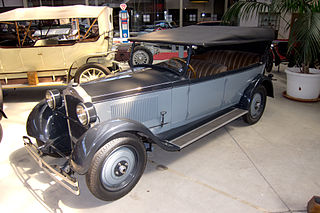
The Opel 7/34 PS is a large but relatively inexpensive six-cylinder-powered car manufactured by Opel, introduced in October 1927. It was replaced in 1928 by the Opel 8/40 PS which was virtually identical except that the cylinder capacity had been increased. Significant changes to the chassis took place in February 1929, after which production of the model continued till September 1930. The 8/40 PS was replaced by the Opel 1.8 Liter in 1931, also a compact six-cylinder car.
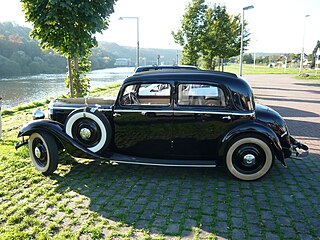
The Mercedes-Benz W 21 was a six-cylinder passenger car launched in 1933 using the name Mercedes-Benz Typ 200. It was one of several Mercedes-Benz models known, in its own time, as the Mercedes-Benz 200 and is therefore in retrospect more commonly referred to using its Mercedes-Benz works number, “W21”.

The Mercedes-Benz W 142 was a six-cylinder passenger car launched in February 1937, as a successor to the Mercedes-Benz Typ 290. The car was known by its name Typ 320 at the time of its production and service, but is in retrospect commonly referred to using its Mercedes-Benz works number, "W142", which gives a more unambiguous, unique nomenclature.
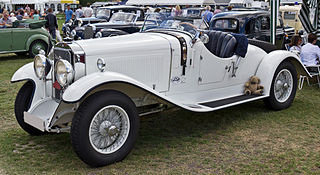
The Mercedes-Benz W08 was a large luxury car produced by Daimler-Benz. It was introduced in Autumn 1928, as Mercedes-Benz's first eight-cylinder passenger car. Also known by various “type numbers”, it remained in production with various modifications and upgrades until the later summer of 1939, the longest lived Mercedes-Benz model of the 1920s and 1930s.

The Mercedes-Benz W18 was a six-cylinder automobile introduced as the Mercedes-Benz Typ 290 in 1933. It was a smaller-engined successor to the manufacturer’s Typ 350 / 370 Mannheim model. In terms of the German auto-business of the 1930s it occupied a market position roughly equivalent to that filled by the Mercedes-Benz E-Class in the closing decades of the twentieth century. The W18 was replaced in 1937 by the manufacturer’s W142.
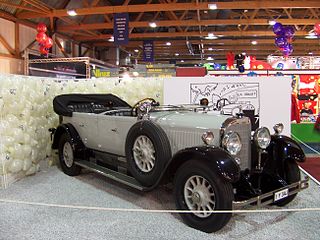
The Mercedes 15/70/100 PS was a large automobile introduced by Daimler in 1924. Production continued till 1929 by which time Daimler had merged with Benz & Cie as a result of which the car's name had changed to Mercedes-Benz Typ 400.

The Mercedes 24/100/140 PS was a large luxury car introduced by Daimler of Untertürkheim in 1924. Production continued until 1929 by which time Daimler had merged with Benz & Cie and the car's name changed to Mercedes-Benz Typ 630. The car was conceptually and structurally similar to the contemporary Mercedes 15/70/100 PS, but the 24/100/140 PS was longer, heavier, more powerful, faster and more expensive.

The Mercedes-Benz W02 was a midsize six-cylinder two-litre-engined automobile introduced by Daimler-Benz at the Berlin Motor Show in October 1926. It was developed in some haste under the manufacturer's Technical Director, Ferdinand Porsche in parallel with the smaller Mercedes-Benz W 01 and the larger three-litre-engined Mercedes-Benz W03 following the creation of Daimler-Benz, formally in July 1926, from the fusion of the Daimler and Benz & Cie auto-businesses.
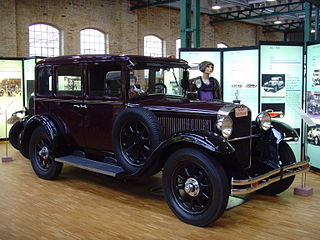
The Mercedes-Benz W11 was a midsize six-cylinder automobile introduced by Daimler-Benz it 1929. It was developed from the Mercedes-Benz W02 first seen in 1926, and the W11 shared its chassis and bodywork with the W02, but the W11 came with a larger more powerful engine, a new name and a wider list of “standard bodies” from which customers could choose.

The Mercedes-Benz W03 was a large six-cylinder-engined automobile introduced as the Mercedes-Benz 12/55 PS and, initially, as the Mercedes-Benz Typ 300, by Daimler-Benz at the Berlin Motor Show in October 1926. It was developed in some haste under the manufacturer's Technical Director, Ferdinand Porsche in parallel with the smaller Mercedes-Benz W 01 and the two-litre-engined Mercedes-Benz W02 following the creation of Daimler-Benz, formally in July 1926, from the fusion of the Daimler and Benz & Cie auto-businesses.

The Unimog 401 is an all-wheel-drive vehicle of the Unimog-series by Mercedes-Benz, developed as a tractor and equipment carrier. It was produced by Daimler-Benz in the Unimog plant in Gaggenau from 1953 to 1956. A total of 16,250 Unimog 401 and 402 were made.
The Mercedes-Benz M11 engine is a naturally-aspirated, 2.6-liter, straight-6, internal combustion piston engine, designed, developed and produced by Mercedes-Benz; between 1929 and 1935.



















